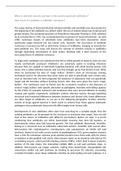What is selecti ve toxicity and how is this used to generate anti bioti cs?
How much of a problem is anti bioti c resistance?
The major decline of bacterial infection-related mortality and morbidity was documented at
the beginning of the antibiotic era, before which the use of antimicrobials was empirical and
greatly limited. The accidental discovery of Penicillin by Alexander Fleming in 1928, followed
by its introduction in 1942, has revolutionized the treatment of bacterial infection. Up until
1980, numerous classes of selectively toxic antibiotics had been discovered, which
specifically target bacterial but not human cells. However, the occurrence of antibiotic
resistance in bacteria has left us with fewer choices of antibiotics, bringing us towards the
post-antibiotic era. This essay will discuss the concept of selective toxicity in antibiotics
through illustrating mechanisms of their action, finishing with a brief account of the
increasing threat of antibiotic resistance.
To begin with, antibiotics are substances that kill or inhibit growth of bacteria, they are now
mostly synthetically produced. Antibiotics are extremely useful in treating infections
because they are capable of selectively targeting bacterial cells while leaving human cells
intact, this is called selective toxicity, and was first brought up by Paul Ehrlich in the 1890s
when he postulated the idea of ‘magic bullets’. Ehrlich’s work on microscopy staining
techniques lead to his discovery that some stains are able to specifically stain certain cells,
such as microbial cells. He then proposed the existence of substances that can specifically
target and kill microbes without harming human cells, they were given the name ‘magic
bullets’. The continuous work of Ehrlich and his co-workers resulted in the discovery of
several ‘magic bullets’ with specific attraction to pathogenic microbes with killing capacity
by the 1910s, for example, Salvarsan and methylene blue were proved effective in treating
malaria and syphilis respectively. Antibiotics achieve selective toxicity through exploiting
structural and functional differences between bacterial and human cells, these differences
are often target of antibiotics, as we see in the following paragraphs. Further, selective
toxicity of drugs against bacteria is much easier to achieve than those against eukaryotic
pathogens since prokaryotic bacterial cells differ largely from human cells.
Development of new antibiotics often start from searching for a suitable target, thus the
existing antibiotics can be grouped by the structures or processes they target. Here we will
look at five classes of antibiotics with different mechanisms. Before we start, it is worth
mentioning that antibiotics are either bactericidal meaning that they kill bacteria, or
bacteriostatic where they halt bacterial growth. The first antibiotic discovered, Penicillin,
belong to a structural class of antibiotics called beta-lactams. Penicillin with several other
beta-lactams like cephalosporins, monobactams and carbapenems all inhibit cell wall
synthesis. Bacterial cell walls consist mainly of peptidoglycans (PG), gram-negative bacteria
have a thin PG monolayer whereas gram-positive bacteria have thick walls with PG chains
crosslinked at tetrapeptide side chains. Beta-lactams taken up by bacterial cells bind to PG
crosslinking enzyme called penicillin binding proteins (PBPs), which bind D-alanyl D-alanine
portion of PG side chains, the interaction inhibits PBPs so cell wall synthesis stops. In
addition, beta-lactams can trigger autolysis, making them bactericidal. Glycopeptides like
vancomycin inhibit cell wall synthesis by binding to precursor PG subunits, preventing
crosslink formation. Since these antibiotics function by interrupting cell wall synthesis, it is




